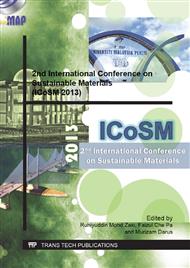[1]
A.M. Rimaldo, P.M. Perkins-Veazie, Determination of citrulline in watermelon rind. Journal of Chromatography. 1075 (2005) 196-200.
DOI: 10.1016/j.chroma.2005.05.009
Google Scholar
[2]
A.F. Mohamed Baraka, A.B.A. Abu Goukh, M.M. Ali Elballa, Physico-chemical changes during growth and development of 'Galia' canteloupes. Physical changes. Agricultural and Biology Journal of North America. 2 (2011) 944-951.
DOI: 10.5251/abjna.2011.2.6.944.951
Google Scholar
[3]
G. Crini, Recent developments in polysaccharide-based materials used as adsorbents in wastewater treatment. Progress in Polymer Science. 30 (2005) 38-70.
DOI: 10.1016/j.progpolymsci.2004.11.002
Google Scholar
[4]
F.A. Pavan, I.S. Lima, E.C. Lima, C. Airoldi, Y. Gushikem, Use of Ponkan mandarin peels as biosorbent for toxic metals uptake from aqueous solutions. 137 (2006) 527-533.
DOI: 10.1016/j.jhazmat.2006.02.025
Google Scholar
[5]
A. Saeed, M.W. Akhter, M. Iqbal, Removal and recovery of heavy metals from aqueous solution using papaya wood as new biosorbent. Separation and Purification Technology. 45 (2005) 25-31.
DOI: 10.1016/j.seppur.2005.02.004
Google Scholar
[6]
E.S.Z. El-Ashtoukhy, N.K. Amin, O. Abdelwahab, Removal of lead (II) and copper (II) from aqueous solution using pomegranate peel as a new adsorbent. Desalination. 223 (2008) 162-173.
DOI: 10.1016/j.desal.2007.01.206
Google Scholar
[7]
R. A-Jacques, E.C. Lima, S.L.P. Dias, A.C. Mazzocato, F.A. Pavan, Yellow passion-fruit shell as biosorbent to remove Cr (III) and Pb (II) from aqueous solution. Separation and Purification Technology. 57 (2007) 193-198.
DOI: 10.1016/j.seppur.2007.01.018
Google Scholar
[8]
C. Liu, H.H. Ngo, W. Guo, Watermelon rind: Agro-waste or superior biosorbent?. Application of Biochemistry and Biotechnology. 2012.
DOI: 10.1007/s12010-011-9521-7
Google Scholar
[9]
G.M. Madhavi, P.T.K. Mulgund, M.R. Sanandam, Biosorptive removal of heavy metals (Cd+2, Pb+2 and Cu+2) from Aqueous solutions by Cassia angustifolia bark. International Journal of Engineering Science and Technology. 3 (2011) 1642-1647.
Google Scholar
[10]
S. Qaiser, A.R. Saleemi, M. Umar, Biosorption of lead(II) and chromium(VI) on groundnut hull: Equilibrium, kinetics and thermodynamics study. Electronic Journal of Biotechnology. (2009).
DOI: 10.2225/vol12-issue4-fulltext-6
Google Scholar
[11]
A.W. Mohamed, J. Salah, J. Naceur, Ammonium biosorption onto sawdust: FTIR analysis, kinetics and adsorption isotherms modeling. Bioresource Technology. 101 (2010) 5070-5075.
DOI: 10.1016/j.biortech.2010.01.121
Google Scholar
[12]
S. Kamsonlian, C. Balomajumder, S.Chand and S. Suresh, Biosorption of Cd (II) and As (III) ions from aqueous solution by tea waste biomass. African Journal of Environmental Science and Technology. 5 (2011) 1-7.
Google Scholar
[13]
A. Saeed, M. Iqbal, M.W. Akhtar, Removal and recovery of lead(II) from single and multimetal (Cd, Cu, Ni, Zn) solution by crop milling waste (black gram husk). Journal of Hazardous Materials. 117 (2005) 64-67.
DOI: 10.1016/j.jhazmat.2004.09.008
Google Scholar
[14]
Z. Reddad, C. Gerente, Y. Andres, P. Le Cloirec, Mechanisms of Cr(III) and Cr(VI) removal from aqueous solutions by sugar beet pulp. 24 (2003) 257-264.
DOI: 10.1080/09593330309385557
Google Scholar


